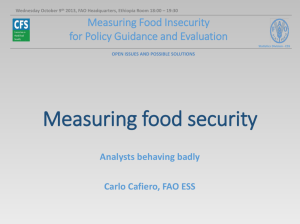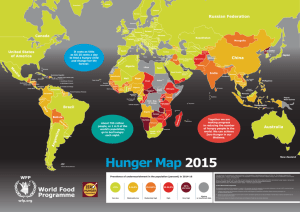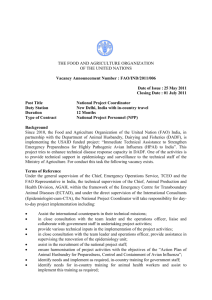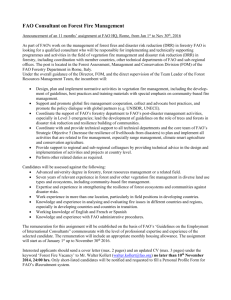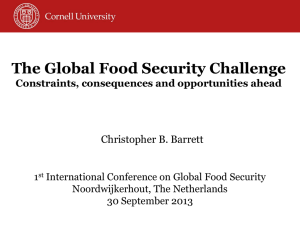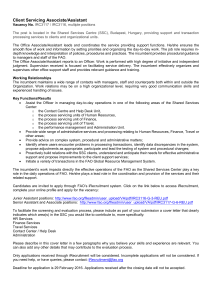Terms of Reference Annex on FAO Global Goals and Strategic
advertisement
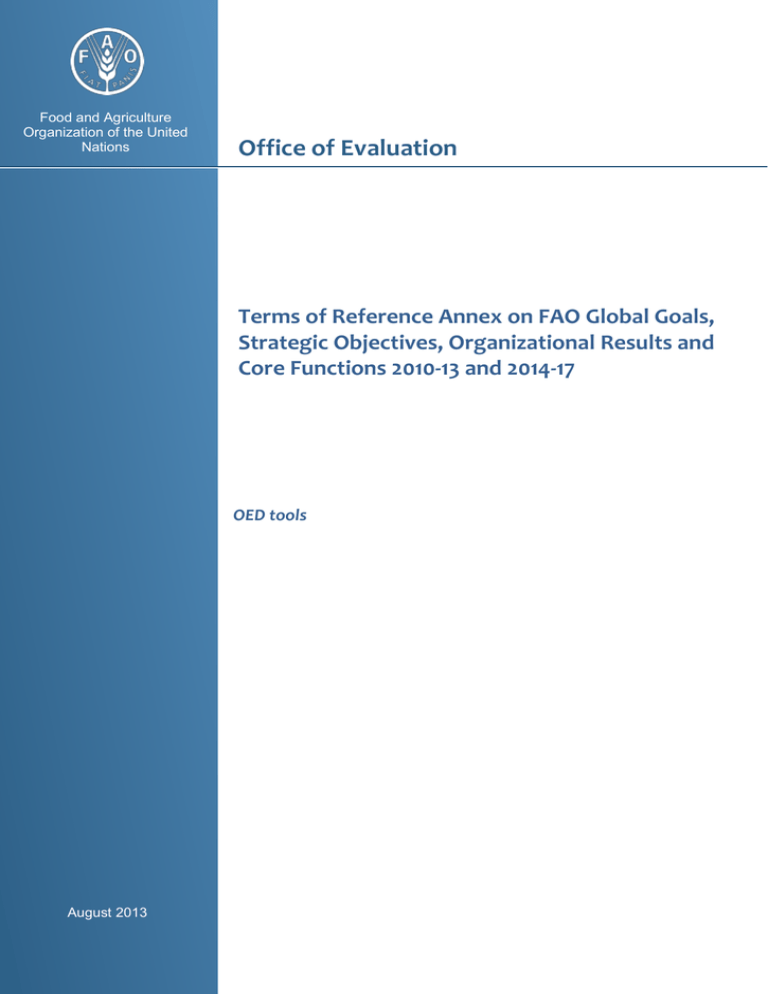
Food and Agriculture Organization of the United Nations Office of Evaluation Template Terms of Reference for the separate evaluation of projects and programmes funded throughAgriculture voluntary Food and contributions by resource partners Organization of the United Nations Terms of Reference Annex on FAO Global Goals, Strategic Objectives, Organizational Results and Core Functions 2010-13 and 2014-17 OED tools August 2013 Food and Agriculture Organization of the United Nations Office of Evaluation (OED) This report is available in electronic format at: http://www.fao.org/evaluation The designations employed and the presentation of material in this information product do not imply the expression of any opinion whatsoever on the part of the Food and Agriculture Organization of the United Nations (FAO) concerning the legal or development status of any country, territory, city or area or of its authorities, or concerning the delimitation of its frontiers or boundaries. The mention of specific companies or products of manufacturers, whether or not these have been patented, does not imply that these have been endorsed or recommended by FAO in preference to others of a similar nature that are not mentioned. The views expressed in this information product are those of the author(s) and do not necessarily reflect the views or policies of FAO. © FAO 2013 FAO encourages the use, reproduction and dissemination of material in this information product. Except where otherwise indicated, material may be copied, downloaded and printed for private study, research and teaching purposes, or for use in non-commercial products or services, provided that appropriate acknowledgement of FAO as the source and copyright holder is given and that FAO’s endorsement of users’ views, products or services is not implied in any way. All requests for translation and adaptation rights, and for resale and other commercial use rights should be made via www.fao.org/contact-us/licence-request or addressed to copyright@fao.org. For further information on this report, please contact: Director, OED Viale delle Terme di Caracalla 1, 00153 Rome, Italy Email: evaluation@fao.org OED, Terms of Reference Annex, FAO goals, objectives and core functions Box 1. FAO Members Global Goals Global Goals 2010-13 Global Goals 2014-17 a) Reduction of the absolute number of people suffering from hunger, progressively ensuring a world in which all people at all times have sufficient safe and nutritious food that meets their dietary needs and food preferences for an active and healthy life; Eradication of hunger, food insecurity and malnutrition, progressively ensuring a world in which people atall times have sufficient safe and nutritious food that meets their dietary needs and food preferences for an active and healthy life; b) Elimination of poverty and the driving forward of economic and social progress for all with increased food production, enhanced rural development and sustainable livelihoods; Elimination of poverty and the driving forward of economic and social progress for all, with increased food production, enhanced rural development and sustainable livelihoods; c) Sustainable management and utilisation of natural resources, including land, water, air, climate and genetic resources, for the benefit of present and future generations. Sustainable management and utilization of natural resources, including land, water, air, climate and genetic resources for the benefit of present and future generations. Box 2. FAO Strategic Objectives and Organizational Results 2010-13 Code Title Lead Unit A Sustainable intensification of crop production AG A01 Policies and strategies on sustainable crop production intensification and diversification at national and regional levels AGP A02 Risks from outbreaks of transboundary plant pests and diseases are sustainably reduced at national, regional and global levels AGP A03 Risks from pesticides are sustainably reduced at national, regional and global levels AGP A04 Effective policies and enabled capacities for a better management of plant genetic resources for food and agriculture (PGRFA) including seed systems at the national and regional levels AGP B Increased sustainable livestock production AG B01 The livestock sector effectively and efficiently contributes to food security, poverty alleviation and economic development AGA B02 Reduced animal disease and associated human health risks AGA B03 Better management of natural resources, including animal genetic resources, in livestock production AGA B04 Policy and practice for guiding the livestock sector are based on timely and reliable information AGA C Sustainable management and use of fisheries and aquaculture resources FI C01 Members and other stakeholders have improved formulation of policies and standards that facilitate the implementation of the Code of Conduct for Responsible Fisheries (CCRF) and other international instruments, as well as response to emerging issues Governance of fisheries and aquaculture has improved through the establishment or strengthening of national and regional institutions, including RFBs FI C02 3 FIE OED, Terms of Reference Annex, FAO goals, objectives and core functions More effective management of marine and inland capture fisheries by FAO Members and other stakeholders has contributed to the improved state of fisheries resources, ecosystems and their sustainable use Members and other stakeholders have benefited from increased production of fish and fish products from sustainable expansion and intensification of aquaculture FIM Operation of fisheries, including the use of vessels and fishing gear, is made safer, more technically and socio-economically efficient, environmentally-friendly and compliant with rules at all levels Members and other stakeholders have achieved more responsible post-harvest utilization and trade of fisheries and aquaculture products, including more predictable and harmonized market access requirements Improved quality and safety of food at all stages of the food chain FII D01 New and revised internationally agreed standards and recommendations for food safety and quality that serve as the reference for international harmonization AGN D02 Institutional, policy and legal frameworks for food safety/quality management that support an integrated food chain approach AGN D03 National/regional authorities are effectively designing and implementing programmes of food safety and quality management and control, according to international norms AGN D04 AGN E Countries establish effective programmes to promote improved adherence of food producers/businesses to international recommendations on good practices in food safety and quality at all stages of the food chain, and conformity with market requirements Sustainable management of forests and trees E01 Policy and practice affecting forests and forestry are based on timely and reliable information FOM E02 Policy and practice affecting forests and forestry are reinforced by international cooperation and debate FOE E03 Institutions governing forests are strengthened and decision-making improved, including involvement of forest stakeholders in the development of forest policies and legislation, thereby enhancing an enabling environment for investment in forestry and forest industries. Forestry is better integrated into national development plans and processes, considering interfaces between forests and other land uses Sustainable management of forests and trees is more broadly adopted, leading to reductions in deforestation and forest degradation and increased contributions of forests and trees to improve livelihoods and to contribute to climate change mitigation and adaptation Social and economic values and livelihood benefits of forests and trees are enhanced, and markets for forest products and services contribute to making forestry a more economicallyviable land-use option Environmental values of forests, trees outside forests and forestry are better realized; strategies for conservation of forest biodiversity and genetic resources, climate change mitigation and adaptation, rehabilitation of degraded lands, and water and wildlife management are effectively implemented Sustainable management of land, water and genetic resources and improved responses to global environmental challenges affecting food and agriculture FOE F01 Countries promoting and developing sustainable land management NRL F02 Countries address water scarcity in agriculture and strengthen their capacities to improve water productivity of agricultural systems at national and river-basin levels including transboundary water systems Policies and programmes are strengthened at national, regional and international levels to ensure the conservation and sustainable use of biological diversity for food and agriculture and the equitable sharing of benefits arising from the use of genetic resources NRL C03 C04 C05 C06 D E04 E05 E06 F F03 4 FIM FII AG FO FOM FOE FOM NR NRD OED, Terms of Reference Annex, FAO goals, objectives and core functions An international framework is developed and countries' capacities are reinforced for responsible governance of access to, and secure and equitable tenure of land and its interface with other natural resources, with particular emphasis on its contribution to rural development Countries have strengthened capacities to address emerging environmental challenges, such as climate change and bioenergy NRC F06 Improved access to and sharing of knowledge for natural resource management OEK G Enabling environment for markets to improve livelihoods and rural development ES G01 Appropriate analysis, policies and services enable small producers to improve competitiveness, diversify into new enterprises, increase value addition and meet market requirements Rural employment creation, access to land and income diversification are integrated into agricultural and rural development policies, programmes and partnerships F04 F05 G02 NRC ESW G03 National and regional policies, regulations and institutions enhance the developmental and poverty reduction impacts of agribusiness and agro-industries G04 Countries have increased awareness of and capacity to analyse developments in international agricultural markets, trade policies and trade rules to identify trade opportunities and to formulate appropriate and effective pro-poor trade policies and strategies EST H Improved food security and better nutrition ES H01 Countries and other stakeholders have strengthened capacity to formulate and implement coherent policies and programmes that address the root causes of hunger, food insecurity and malnutrition Member countries and other stakeholders strengthen food security governance through the triple-track approach and the implementation of the Voluntary Guidelines to Support the Progressive Realization of the Right to Adequate Food in the Context of National Food Security Strengthened capacity of member countries and other stakeholders to address specific nutrition concerns in food and agriculture ESA H04 Strengthened capacity of member countries and other stakeholders to generate, manage, analyse and access data and statistics for improved food security and better nutrition ESS H05 Member countries and other stakeholders have better access to FAO analysis and information products and services on food security, agriculture and nutrition, and strengthened own capacity to exchange knowledge Improved preparedness for, and effective response to, food and agricultural threats and emergencies ESA Countries' vulnerability to crisis, threats and emergencies is reduced through better preparedness and integration of risk prevention and mitigation into policies, programmes and interventions Countries and partners respond more effectively to crises and emergencies with food and agriculture-related interventions TCE I03 Countries and partners have improved transition and linkages between emergency, rehabilitation and development TCE K Gender equity in access to resources, goods, services and decision-making in the rural areas ES K01 Rural gender equality is incorporated into UN policies and joint programmes for food security, agriculture and rural development ESW K02 Governments develop enhanced capacities to incorporate gender and social equality issues in agriculture, food security and rural development programmes, projects and policies using sexdisaggregated statistics, other relevant information and resources ESW H02 H03 I I01 I02 5 ESA AGN TC TCE OED, Terms of Reference Annex, FAO goals, objectives and core functions K03 Governments are formulating gender-sensitive, inclusive and participatory policies in agriculture and rural development ESW K04 FAO management and staff have demonstrated commitment and capacity to address gender dimensions in their work ESW L Increased and more effective public and private investment in agriculture and rural development TC L01 Greater inclusion of food and sustainable agriculture and rural development investment strategies and policies into national and regional development plans and frameworks TCI L02 Improved public and private sector organisations' capacity to plan, implement and enhance the sustainability of food and agriculture and rural development investment operations TCI L03 Quality assured public/private sector investment programmes, in line with national priorities and requirements, developed and financed TCI Box 3. FAO Strategic Objectives 2014-17 1 Contribute to the eradication of hunger, food insecurity and malnutrition 2 Increase and improve provision of goods and services from agriculture, forestry and fisheries in a sustainable manner 3 Reduce rural poverty 4 Enable more inclusive and efficient agricultural and food systems at local, national and international levels 5 Increase the resilience of livelihoods to threats and crises Objective 6 Technical quality, knowledge and services Box 4. FAO Functional Objectives 2014-17 8. Outreach 9. Information Technology 10. FAO Governance, oversight and direction 11. Efficient and effective administration Box 5. FAO Core Functions 2010-13 and 2014-17 Core functions 2010-13 a b c Monitoring and assessment of long-term and medium-term trends and perspectives Assembly and provision of information, knowledge and statistics Development of international instruments, norms and standards Core functions 2014-17 2 1 6 Assemble, analyze, monitor and improve access to data and information, in areas related to FAO´s mandate Facilitate and support countries in the development and implementation of normative and standard- OED, Terms of Reference Annex, FAO goals, objectives and core functions d Policy and strategy options and advice 3 4 e Technical support to promote technology transfer and build capacity 5 f Advocacy and communication 7 g Inter-disciplinarity and innovation h Partnerships and alliances Box 6. 6 FAO cross-cutting themes 2014-17 Gender Governance 7 setting instruments, such as international agreements, codes of conduct, technical standards and others Facilitate, promote and support policy dialogue at global, regional and country levels Advise and support capacity development at country and regional level to prepare, implement, monitor and evaluate evidence-based policies, investments and programmes Advise and support activities that assemble, disseminate and improve the uptake of knowledge, technologies and good practices in the areas of FAO’s mandate Advocate and communicate at national, regional and global levels, in areas of FAO’s mandate Facilitate partnerships for food security and nutrition, agriculture and rural development, between governments, development partners, civil society and the private sector

